Ten journalists and two police officers were murdered in Paris Wednesday as hooded gunmen stormed the offices of the satirical magazine Charlie Hebdo, an act of terror whose implications for free speech has both cowed and emboldened news groups.
“We’ve got to stand up for the right to take the p–s out of these monsters, these idiots, these fools, these posturing maniacs who strut around in their black gear as a kind of death cult trying to frighten us all,” English political cartoonist Steve Bell said in response to the attack.
Gunmen reportedly targeted Charlie Hebdo for its repeated mocking of Islam and the prophet Muhammad. The magazine’s previous offices were also firebombed in 2011 after it announced Muhammad would join the magazine as a guest editor-in-chief in honor of the so-called “Arab Spring.”
How journalists should respond to terrorist threats has been an issue since a Danish newspaper published a series of cartoons about Muhammad that caused an uproar in the Muslim community.
And it appears the Paris attack has already prompted some news groups to self-censor what they publish concerning Islam.
The Telegraph, for example, published a report, titled “Paris Charlie Hebdo attack: live,” that closely followed the details of the attack. However, included in the original report was a censored image of one of Charlie Hebdo’s supposedly offensive front pages:
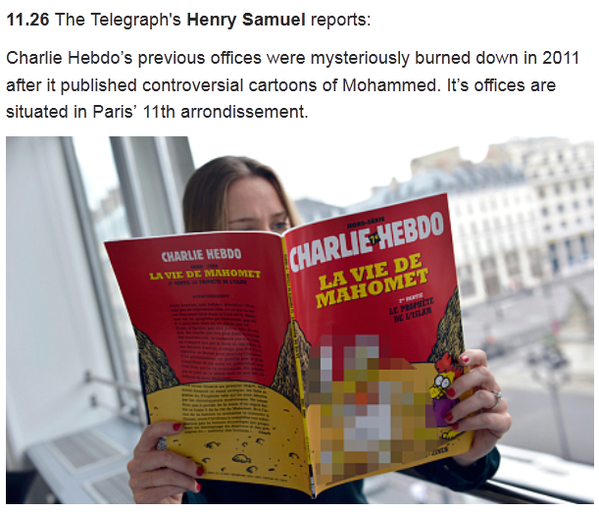
The Telegraph has since removed the blurred-out image. The closest the British newspaper comes to republishing one of the satirical magazine’s “offensive” front pages is a heavily cropped photo a Charlie Hebdo editorial director Stéphane Charbonnier, who was killed Wednesday.
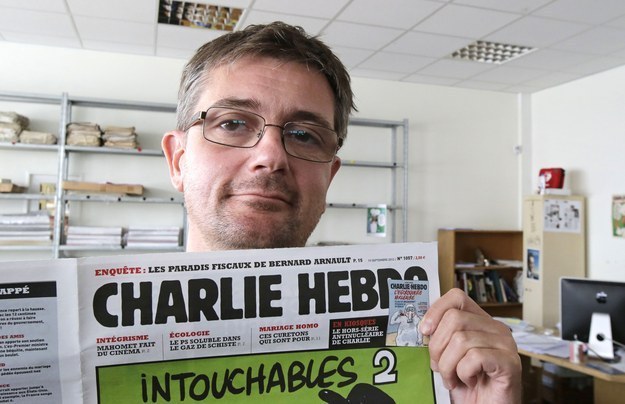
The above photo of Stéphane Charbonnier is from the Associated Press. Three additional photos of the late news director that were taken at the same time and included on the Associated Press wire this morning are from non-AP photographers.
The non-AP photos included the magazine’s cartoon.
“AP moved only one photo that did not show the cartoon,” the Associated Press’ Erin Madigan told the Washington Examiner. “The others you reference are SIPA photos that were automatically fed into AP images, the commercial photo unit of AP (different from the AP “wire”). They have since been removed from AP images.”
SIPA is a Paris-based photo agency.
The Associated Press explained that it cropped the cartoon out its official photo because it is has been their “policy for years that we refrain from moving deliberately provocative images.”
Elsewhere, the New York Daily News on Wednesday published two separate articles that blurred Charlie Hebdo’s “offensive” front pages completely.
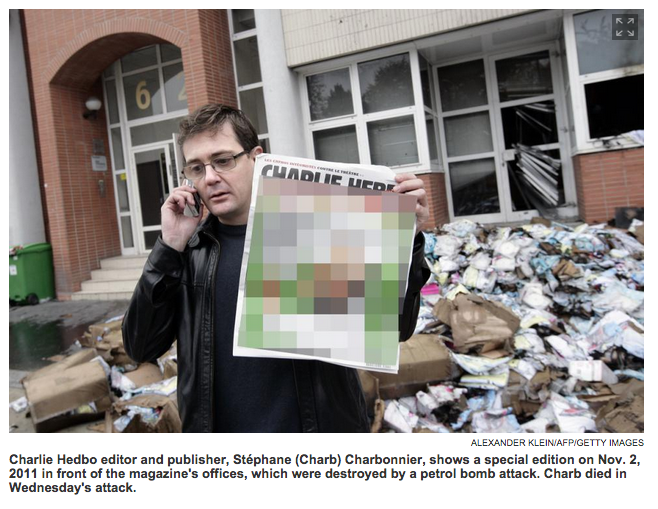
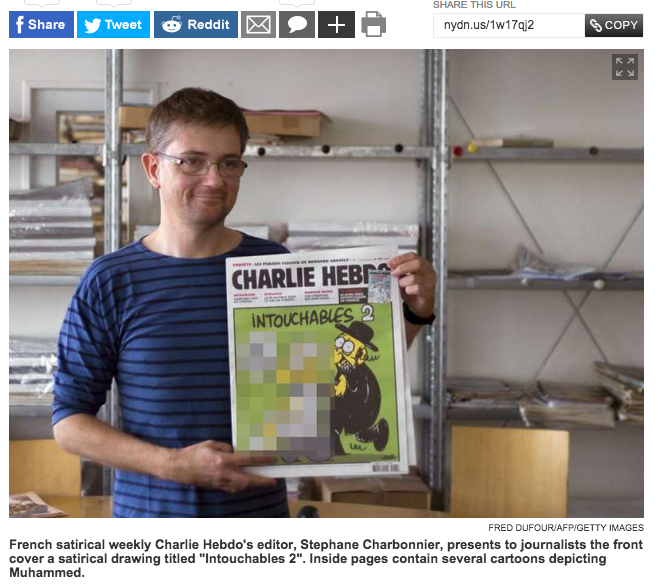
Neither the Telegraph nor the New York Daily News responded to requests for comment.
Among cable news networks, CNN’s handling of the attack has been confused.
Initially, the network reported early Wednesday that Islamic extremists might have carried out the attacks over “offensive” cartoons.
As that was being reported, the network did not shy away from republishing one of Charlie Hebdo’s “offensive” covers.
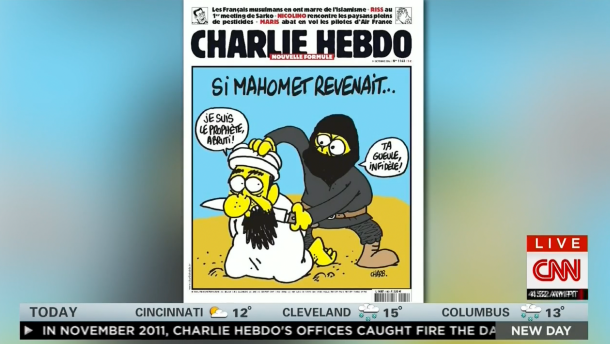
However, as the day progressed, CNN traded cartoons for closely cropped photos of Charbonnier, eventually releasing a memo that afternoon stating that the magazine’s controversial covers should be avoided altogether.
“Although we are not at this time showing the Charlie Hebdo cartoons of the Prophet considered offensive by many Muslims, platforms are encouraged to verbally describe the cartoons in detail,” an internal CNN memo obtained by Politico stated.
“Video or stills of street protests showing Parisians holding up copies of the offensive cartoons, if shot wide, are also OK. Avoid close-ups of the cartoons that make them clearly legible.”
It’s also OK to show most of the protest cartoons making the rounds online, though care should be taken to avoid examples that include within them detailed depictions of the Charlie Hebdo cartoons,” it added.
But other media groups were much less timid in the face of the Paris horrors.
Multiple news outlets, including the Daily Beast, Bloomberg and

The Washington Free Beacon, enshrined the satirical French magazine’s most biting commentary on Islam, taking a stand against those who would silence criticism and satire.
The Daily Beast published a slideshow, titled “The 16 most shocking Charlie Hebdo covers,” that certainly delivers what it promises.
The Washington Free Beacon, for its part, published an article, titled “A Tribute to Charlie Hebdo,” that presents its readers with “the cartoons that jihadist fanatics don’t want you to see.”

Elsewhere, Bloomberg launched a slideshow of its own, titled “The Bold Charlie Hebdo Covers the Satirical Magazine Was Not Afraid to Run,” that republished said covers in their entirety. No blurring, cropping or editing.
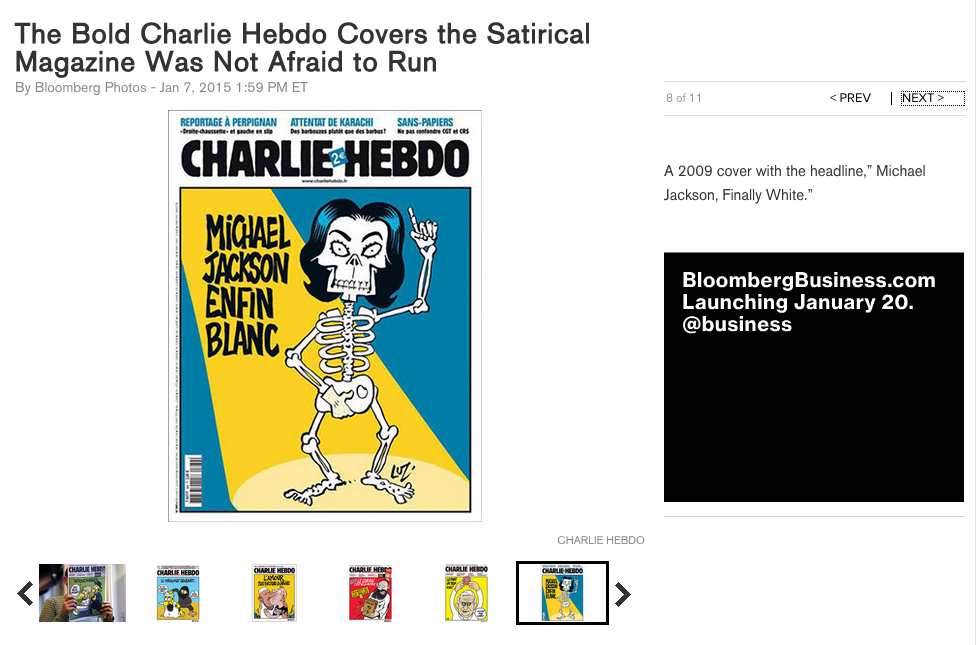
Yahoo News reported late Wednesday that the three men responsible for the attack included two brothers aged 32 and 34, and a third man aged 18. The trio are from the northeastern city of Reims, the government source told Reuters.
One of the three men had previously been charged with terrorist activity.

